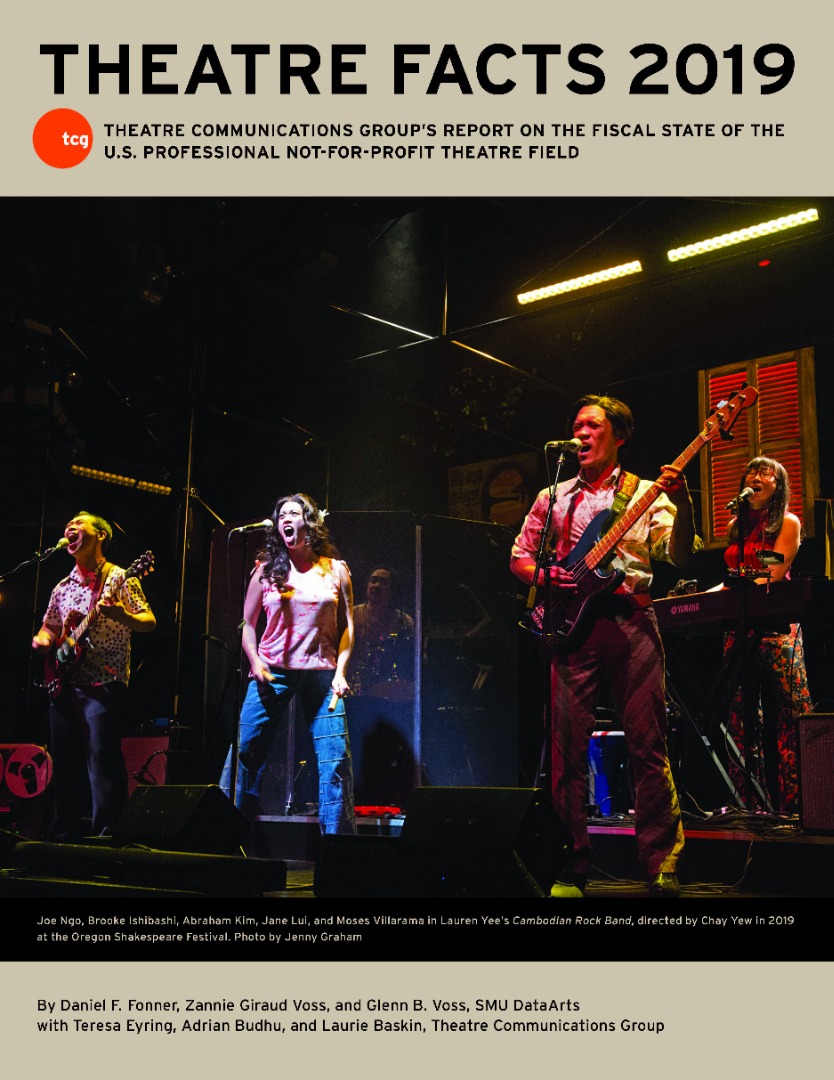- DataArts News
The Nonprofit Theatre Sector Contributed Over $2.8 Billion to the U.S. Economy in 2019
- Posted Nov 25, 2020
A new report from Theatre Communications Group (TCG) examines data on attendance, performance and overall fiscal health of the nonprofit theatre sector to emphasize its significant artistic, educational and economic contributions as we strategize rebuilding for the future.
The 40th annual Theatre Facts report reveals that the nonprofit theatre sector added over $2.8 billion to the U.S. economy through direct payments of goods and services, but its true impact is actually far greater. Nonprofit theatres operate within the economic ecosystem of any given community; as production season draws crowds to the area, it supports jobs and brings business to local restaurants, bars, hotels, etc. In 2019, the national sector supported the employment of 145,000 artists, administrators and technical production staff to help serve an estimated 38 million audience members of all ages, demographics and education levels. Both of these numbers had seen positive trends from 2015 to 2019, but future reportings are likely to look very different.

During any typical year, theatres would be packed with friends and family celebrating the holiday season, but COVID-19 cases now surge as a second wave sweeps across the country. As of today, the CDC reports 14.6 million COVID-19 cases in the U.S. and several states have already implemented stay-at-home or curfew orders for the second time within the year. The few theatres that had reopened since the initial lockdown in March may be forced to close their doors once again without a clear sight of when normal operations should resume.
But in the words of Martin Luther King Jr., “Every crisis has both its dangers and its opportunities.” The theatre field is resilient and innovative. Despite the challenges, many theatres worked swiftly to adapt to the newly dominant virtual landscape early in the pandemic. Offering online programming during these difficult times became essential, and the demand for this switch underscored the important role that the arts play in the health of our society, particularly on a psychological level.
However, the pandemic hasn’t been the only crisis we’ve faced as a society this year. Civil unrest and a call for immediate action against systemic racism have also been at the forefront of conversation, including within the arts. Two weeks after the death of George Floyd and the rise of a nationwide Black Lives Matter movement, more than 300 theater artists — all of whom are BIPOC (Black, Indigenous and people of color) — published a powerful statement condemning racial injustice within the industry. This isn’t about one theatre’s practices, or theatres in any particular region. It’s a call for collective effort toward meaningful change. The statement addressed to “White American Theater” is accompanied by a comprehensive list of demands and interlinked strategies to take into consideration as we build a reimagined future. This includes casting processes that reflect the cultural specificity of the shows being cast, equitable access for BIPOC audiences, transparency in fundraising and the distribution of funds as it relates to BIPOC artists’ work, and much more.
While the methods and practices in which we serve and represent our communities may look different moving forward, the outcomes have the opportunity to be more impactful than ever before. “We should not forget the essential role that theatres play in fueling creative expression, community development, emotional health, cultural literacy, and social cohesion and integration,” says report co-author Dr. Zannie Voss. Findings from Theatre Facts 2019 can serve as an objective benchmark in understanding the state of the sector prior to this year of profound change.
Key Findings from Theatre Facts 2019
The report estimates that in 2019, 1,953 theatres in the U.S. professional not-for-profit theatre field:

+ Shared the creative work of 88,000 artists with 38 million audience members.
+ Employed artists as the majority of the workforce, with an estimated make up of 61% artistic, 23% production/technical, and 16% administrative professionals.
+ Earned 53% of their income and attracted the remaining 47% through contributed support.
+ Managed a positive Change in Unrestricted Net Assets (CUNA) equivalent to 7.3% of total expenses.
ABOUT THEATRE COMMUNICATIONS GROUP
Theatre Communications Group (TCG) exists to strengthen, nurture, and promote professional theatre in the U.S. and globally. Since its founding in 1961, TCG’s constituency has grown from a handful of groundbreaking theatres to over 700 Member Theatres and affiliate organizations and nearly 10,000 Individual Members. Through its Core Values of Activism, Artistry, Diversity, and Global Citizenship, TCG advances a better world for theatre and a better world because of theatre. TCG offers its members networking and knowledge-building opportunities through research, communications, and events, including the annual TCG National Conference, one of the largest nationwide gatherings of theatre people; awards grants and scholarships, approximately $2 million per year, to theatre companies and individual artists; advocates on the federal level; and through the Global Theater Initiative, TCG's partnership with the Laboratory for Global Performance and Politics, serves as the U.S. Center of the International Theatre Institute. TCG is North America’s largest independent trade publisher of dramatic literature, with 17 Pulitzer Prizes for Drama on the TCG booklist. It also publishes the award-winning American Theatre magazine and ARTSEARCH®, the essential source for a career in the arts. In all of its endeavors, TCG seeks to increase the organizational efficiency of its Member Theatres, cultivate and celebrate the artistic talent and achievements of the field, and promote a larger public understanding of, and appreciation for, the theatre. www.tcg.org.


